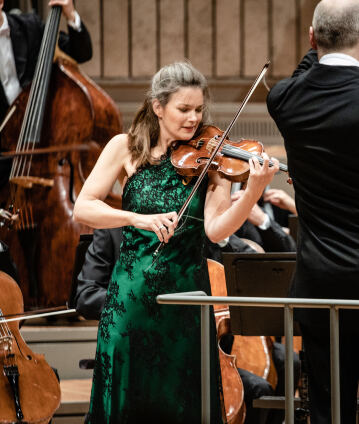Janine Jansen plays Tchaikovsky’s Violin Concerto

The New York Times attests that the violinist Janine Jansen has “a kind of radiant modesty”, and indeed: even in moments of utmost virtuosity, her performances captivate with introspection and substance. This ability is particularly well demonstrated in Tchaikovsky’s Violin Concerto, which, despite its fast yet expressive tempos, is always interspersed with subtle nuances. To bring the concert to a close, Paavo Järvi conducts Robert Schumann’s sonorous and exuberant »Rhenish« Symphony.
Conductor Paavo Järvi, acclaimed for his thrilling interpretations, and charismatic violinist Janine Jansen, who impresses with flawless technical know-how, a masterful sound and the highest level of musical sensitivity, will at these concerts take on two compositions that initially diverged greatly in terms of the public’s acceptance.
Piotr Tchaikovsky’s Violin Concerto, composed after a period of drastic personal crises for the composer, is “unviolinistic”, Leopold Auer, the work’s dedicatee, stated at one time – and thus entrusted it to a colleague to launch Tchaikovsky’s only contribution to the violin concerto genre on 4 December 1881 in Vienna. Hardly anything good could be read about the memorable event in newspapers’ arts pages of the time. Viennese critic Eduard Hanslick even asked his readers the disrespectful question of whether “music can exist which stinks to the ear”. Many years would elapse until Tchaikovsky’s violin concerto, which follows classical formal principles and poses enormous technical demands in the service of realms of expression never heard before, was recognised by audience and press as an epoch-making milestone in the history of the concerto genre.
Robert Schumann’s Third Symphony fared quite differently: when performed for the first time on 6 February 1851 in Düsseldorf, conducted by the composer, the press and public were immediately enthusiastic. Criticism was voiced about the piece, which was composed in just one month, from an unexpected quarter: Schumann’s wife Clara wrote about the last movement that it is “the one that is still least clear to me; it is of the highest art, that I can hear, but I cannot follow it properly”. Later, in a similar vein, Tchaikovsky of all people wrote that he attested Schumann’s composition, despite the “undiminished power of its content, external formal defects” that came to light “ever more perceptibly”. At the end of the day, neither Schumann, who in his own words wanted to awaken “friendlier moods” in his listeners with the Third Symphony, nor his audience, let themselves be put off by this nit-picking. Nowadays the work, which explores completely divergent expressive values in five movements but, thanks to subtle motivic interconnections, nonetheless constitutes a compelling unity, is rightly considered one of Schumann’s symphonic tours de force.
Paavo Järvi has placed Tapiola by Jean Sibelius at the beginning of the programme. The symphonic poem inspired by Finnish tales of nature was commissioned by the American conductor Walter Damrosch, who premiered the work in New York in 1926. It would end up being Sibelius’s last composition for orchestra. Leevi Madetoja, one of Sibeliusʼs students, described his impressions of Tapiola: “At times we hear the melancholy, repeated call of an elf, at times the elves dance heatedly, at times a lonely wanderer in the woods is giving vent to the pain of life. A beautiful work, technically close to the seventh symphony.”
© 2019 Berlin Phil Media GmbH
Related interviews
Artists
Our recommendations
- Britten’s Violin Concerto with Janine Jansen and Daniel Harding
- Sakari Oramo and Janine Jansen with Sibelius’s Violin Concerto
- An “Oriental Night” with Neeme Järvi and Janine Jansen at the Waldbühne
- Sir Simon Rattle and Janine Jansen
- Paavo Järvi and Stefan Dohr
- Paavo Järvi conducts Beethoven and a world premiere